Please Take Note: This is a review of the final game, but it might change slightly based on the success of the Kickstarter campaign. The game is being reviewed on the components and the rules provided with the understanding that “what you see is not what you might get” when the game is published. If you like what you read and want to learn more, we encourage you to visit the game publisher’s website or visit the Kickstarter campaign. Now that we have all that disclaimer junk out of the way, on with the review.
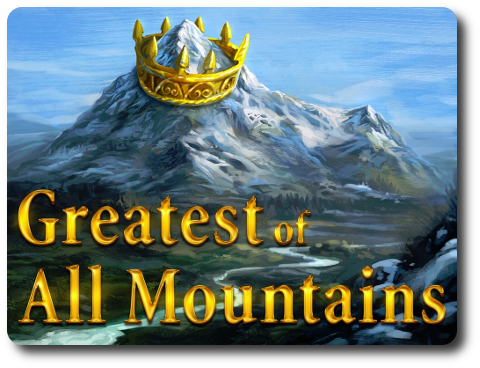
The Basics:
- For ages 8 and up (publisher suggests 10+)
- For 2 to 5 players
- Approximately 70 minutes to complete
Geek Skills:
- Counting & Math
- Logical & Critical Decision Making
- Reading
- Strategy & Tactics
- Hand/Resource Management
Learning Curve:
- Child – Easy
- Adult – Easy
Theme & Narrative:
- If you build your mountain, they will come…
Endorsements:
- Gamer Geek rejected!
- Parent Geek approved!
- Child Geek approved!
Overview
Scottish-American naturalist, author, environmental philosopher, and wilderness preservation advocate John Muir wrote, “The mountains are calling and I must go.” The mountains call to many. They are seen by some as places of spiritual and supernatural power and by others as muses for poems and paintings. They are home to countless animals and aspiring vistas. Visible from miles away, but impossible to fully take in. In this game, you get to make one.
Greatest of All Mountains, designed by Tim Obermueller and to be published by Tim Obermueller Games, will reportedly be comprised of 160 cards. As this is a prepublished game, I will not comment on the game component quality. The proposed artwork is vibrant with color and captures cascading waterfalls, imposing cliffs, and cathedral-like forests. Essentially, everything you’d expect to find on a mountain, but there will also be illustrations for various buildings and points of interest for tourists to visit. Not included in the game, but necessary to play, are a handful of tokens.
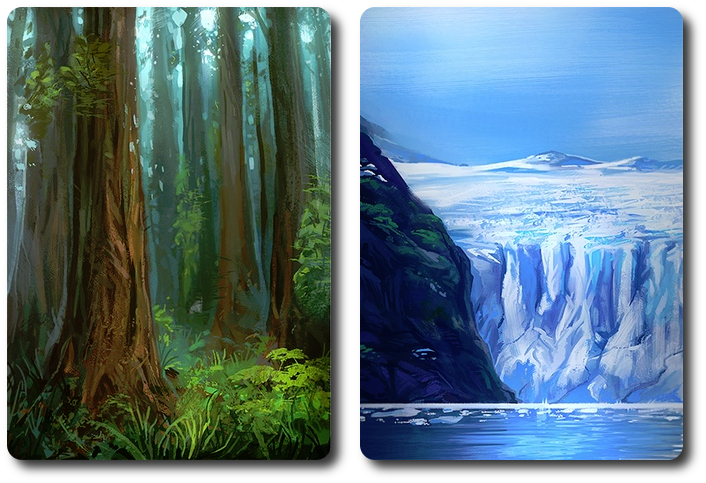
Examples of some of the game’s proposed artwork. On the left, an ancient forest and on the right, an ancient glacier. So cool!
The Birth of a Mountain
To set up the game, first take the cards and separate them by phase. The card backs will have a Roman numeral value of “I”, “II”, or “III”. These indicate the phase in which the card belongs.
Second, take the Phase I deck and find the “Height Token” and “Award” Phase I cards, setting these cards aside for the moment.
Third, shuffle each Phase deck of cards. Set Phase II and Phase III card decks face-down and to one side. We’ll get to these cards later in the game.
Fourth, place the Phase I deck of cards face-down in the middle of the playing area. Place the “Height Tokens” Phase I card next to the Phase I deck, face-up.
Fifth, draw 1 Phase I card from the deck and place it face-up next to the “Height Tokens” Phase I card to form a row. Repeat this for as many players as there are in the game, -1. For example, if you have 4 players, you’ll draw and place 3 Phase I cards next to the “Height Tokens” Phase I card. The end result will be a number of face-up cards equal to the number of players in the game.
Sixth, set the tokens to be used (which can be glass stones, sticks, meeples, and really whatever you got handy) to one side at this time, as well.
That’s it for game set up. The rules state that the first person to have last been on a mountain goes first. As I live in Minnesota, the land of 10,000 lakes and zero mountains, I find this rule to be intolerable. Feel free to determine who the First Player should be and get to it.
Let’s Build a Mountain
Greatest of All Mountains is played in phases, rounds, and turns. Each of the game phases plays differently and are summarized here.
Phase I: Formation
The first phase of the game is focused on creating the player’s mountain. The entire goal of the game is to create a mountain of legendary stature. It need not be the tallest or even the biggest, as the goal of the game is to create something unique. Players should keep that in mind during this first portion of the game.
Starting with the First Player and continuing in turn order sequence, each player will select 1 of the available face-up cards in the row next to the Phase I deck and place it in front of them, keeping it face-up. The only card that will always remain the same in the row is the “Height Tokens” Phase I card. The “Height Tokens” card allows the player to obtain a number of Height Tokens equal to the number of cards in the row, +1. The card cannot be taken if the player has fewer cards than any other opponent. The only exception to this rule is if all the “Terrain” Phase I cards have been claimed or an opponent has already claimed the card for themselves this round.
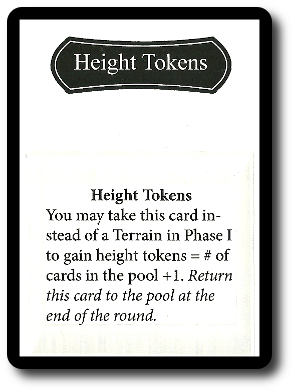
Example does not represent final card
The other possible cards include “Terrain” and “Event” Phase I cards.
“Terrain” Phase I cards represent 1 of 4 possible sides of the player’s mountain. These cards represent snowy slopes, lakes full of fish, and large cliffs just to name a few of the many geographical spots a mountain could possess. When a player selects a “Terrain” Phase I card, it is placed face-up in front of them to form a row. Some of the “Terrain” Phase I cards will provide bonuses for future phases. Each card also has a mountain symbol with a number value. This indicates the number of victory points the “Terrain” card is worth.
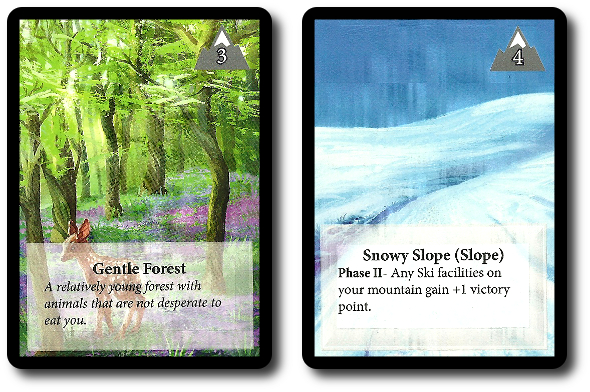
“Event” Phase I cards allow the player to change the “Terrain” cards they previously drew or improve a “Terrain” card. Once the “Event” card is selected, the player reads it out loud, completes the necessary action on the card, and either keeps it or discards it next to the Phase I deck.

Example does not represent final card
After each player has selected a card from the row, the round is over. The player who took the “Height Tokens” Phase I card now returns it, placing it face-up next to the Phase I deck. A number of new cards are drawn equal to the total number of players, -1. A new round now begins.
This continues until all the players have 4 “Terrain” cards in front of them. All remaining Phase I cards are collected and removed for the duration of the game. Only those cards the player selected for their mountain will remain.
Before continuing to the next phase, each player should count their Height tokens collected during this round of game play. The player with the most Height tokens wins the “Award” card for tallest mountain. Give this card to them now. If there is a tie, the taller player wins the award.
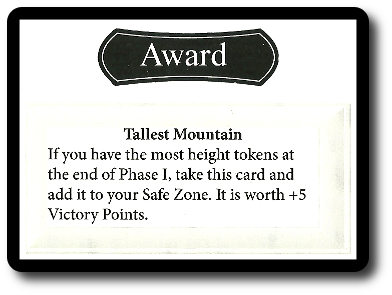
Example does not represent final card
Onward to Phase II!
Phase II: Settlement
After the elements have had time to carve the mountain, grow forests, and fill lakes, it’s time to build structures for the tourists and set aside land to preserve nature. Each player should now count their current total victory points earned. Victory points are found on the upper-right hand corner of the face-up cards with a mountain symbol. The player with the most victory points is the First Player for this phase.
Grab the Phase II deck and deal 2 cards to each player to create their hand. Then deal 4 cards face-up to the table. These cards are referred to as the “Pool”. Place the Phase II deck face-down next to the row. Phase II cards will be placed above or below the “Terrain” cards when they are played. Agree as a group where they should reside during this phase.
Starting with the First Player and continuing in turn order sequence, each player will take 2 actions. The possible actions are as follows:
- Take 1 card from the Pool and play it to a “Terrain” card if the selected card is a “Facility”. If the card is an “Event”, then add the card to your hand. Add another card to the Pool.
- Draw 2 Phase II cards from the deck and add them to your hand.
- Place 1 “Facility” card to 1 of your “Terrain” cards and then draw 1 Phase II card.
- Place 1 “Facility card to 1 of your opponent’s Terrain cards. A new card is NOT drawn.
- Play 1 “Event” card from your hand.
Before a “Facility” card can be played to a “Terrain” card, it must meet certain requirements. If it doesn’t, it cannot be played to that specific “Terrain” card. Only 1 “Facility” may be added to each mountain face, meaning a player will have no more than 4 “Facility” cards. Players should pay very close attention to what “Facility” cards they want to claim, as each provides a special effect during the next phase.
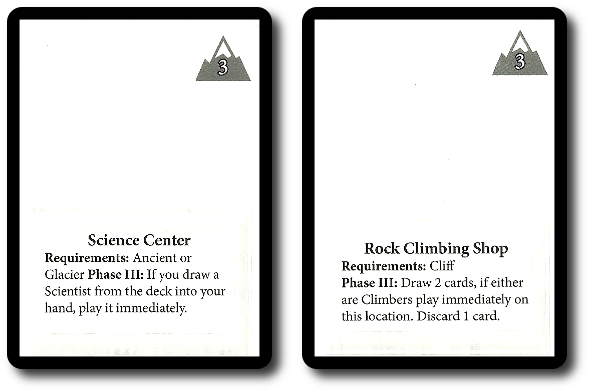
Examples do not represent final cards
If the player already has 4 “Facility” cards, they are not out for the phase. They may continue to take actions, but in a specific priority order. From the following list, the player must take the first action. If they cannot, they must take the second. If they cannot take either, then they must take the third action. If none of the actions are possible, their turn is skipped for the round.
- Play 1 “Event” card from your hand.
- Play 1 “Facility” card from your hand to an opponent’s “Terrain” card.
- Play 1 “Facility” card from the Pool to an opponent’s “Terrain” card.
The above summarized game play for this phase continues with each player taking their 2 actions per turn until all players have 1 “Facility” card above their “Terrain” cards. All remaining Phase II cards not attached to “Terrain” card are now collected and removed from the game.
The tourist season now begins.
Phase III: Tourism
Like the previous phase, have each player count their total victory points earned so far. The player with the most victory points is the First Player for the round of this phase.
So far the players have built a mountain and identified key areas of interest where they built facilities or park preserves. Word has gotten out how beautiful their mountain is and the tourists are on their way.
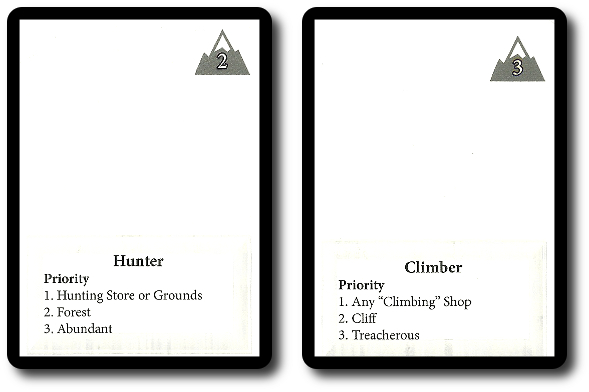
Examples do not represent final cards
To begin, take the Phase III deck and deal 2 cards to each player to start their hand. Then deal 1 Phase III card per player plus 5 more to create the Pool. All cards in the pool should be face-up. Place the Phase III deck next to one side of the Pool face-down.
Each player will now go in turn order sequence, resolving their turn following sequential steps, which I will summarize here.
- Move: The player may move any “Person” cards from a “Facility” card they own to the corresponding “Terrain” card where the facility is located. If any “Person” cards are already on any of the player’s “Terrain” cards, they are removed and placed next to the player. This area is considered a “Safe Zone”.
- Resolve: Each “Facility” has an effect. The player resolves each one in whatever order they like.
- Actions: The player can now take 2 actions. They can draw 1 Phase III card from the deck, take 1 Phase III card from the Pool (playing it next to a “Facility” card), play 1 card from your hand (playing it next to a “Facility” card), or play 1 “Person” card to an opponent’s “Facility” card (which allows the player to draw 2 Phase III cards).
After all the players have taken their turn for the round, any “Event” cards in play are discarded. If any “Person” cards are still in the Pool, the last player for the round takes any “Person” cards in the Pool using the “Person” card priority as a guide, starting with #1. If the player can satisfy the priority, they take the card and play it to listed facility. If not, the next to last player to take their turn this round does the same thing. If none of the “Person” cards can be taken using the first priority, the process repeats itself starting with the second priority and so on. If there are still “Person” cards in the Pool and no one can take them or all the “Person” cards have been claimed, the round ends. Any remaining cards in the Pool are discarded and new cards are placed in the Pool. A new round now begins with the First Player title going to the next player in turn order sequence.
The phase continues as summarized above until there no more cards in the Phase III deck.
The True King of the Mountains
After Phase III ends, the players collect all the cards that have victory points except for “Person” cards that are still located at “Facility” cards. These are out. Any “Person” cards on “Terrain” cards or in the Safe Zone are counted. Any cards without a listed victory point can be removed, as well.
The player with the most victory points wins the game!
Game Variant
The game summarized above is for 3 to 5 players, but Greatest of All Mountains can be played with only 2 players, as well. The only difference in the game play is Phase I. Height tokens are not collected and several “Event” cards are removed from play. Additionally, each player take 1 Phase I card at the start of the game that goes in their hand, then they draw 2 card from the Phase I deck to the Pool. Players can play the card in their hand, drawing a new one afterwards, or play a card from the Pool.
To learn more about Greatest of All Mountains, visit the game publisher’s website or visit the Kickstarter campaign.
Final Word
The Child Geeks were rather taken by the game. They liked the idea of building a mountain and then adding fun things to do and see on it. According to one Child Geek, “This reminds me of those sim[ulation] games I play. I like building mountains and getting people to visit it.” Another Child Geek said, “I like the game, but I was hoping to get some cards that others took and I wasn’t able to make the kind of mountain I wanted.” What kind of mountain, you ask? Volcanoes and such. The abstract idea of a mountain was easy to understand, but the Child Geeks would have been happier if they could create something a bit more concrete. Be that as it may, none of the Child Geeks had any difficulty learning how to play and understanding how to win. Each phase of the game breaks down the whole into meaningful sections that allowed them to focus fully on the task at hand. When all the games were over, the Child Geeks agreed that the game was “pretty good”, if not great.

My oldest takes is time to read each card, while his younger brother looks on, impatiently
The Parent Geeks also enjoyed the game, finding it to be casual and light, with just enough depth and intensity to keep everyone engaged at the gaming table. According to one Parent Geek, “I really enjoyed this game. It felt a little bit like set collecting, but I had a lot of options available to me.” Another Parent Geek said, “This is a great example of a game that is easy to teach and can be played while drinking coffee with friends at the table. The only issue I have with it is the length of play.” A number of our players mentioned this, as well. It would appear that Greatest of All Mountains lasts a bit longer than most of our players thought it should. As one Parent Geek put it, “That’s not always a bad thing, but I was eager for some of the phases to be done so we could get to the next phase that I liked so much better.” When all the games were over, the Parent Geeks all agreed they’d gladly play the Greatest of All Mountains again.
The Gamer Geeks liked a number of things about the game, but were not taken by it. They found it to be a bit too straight forward and the number of victory points to be earned in total depended a bit too much on luck at the start of the game. As one Gamer Geek put it, “You don’t have to be a good player to win this game. You just need to be a lucky one. The cards I select in the first phase will help me in the second and third phase, but I have no idea of knowing how against other players or random cards. That means each decision I make is either blind or so terribly obvious as to make it unnecessary to even think about.” Another Gamer Geek said, “I think this would be a great casual game or a game for non-gamers, but I don’t know if I would want to play this again. It felt a bit to easy and there wasn’t a lot for me to think about, but I did enjoy the game.” None of the Gamer Geeks found the game to be bad, but none of them really believed the game was for them, specifically. They all agreed that they would play the game if asked to by other family members, but would not be looking to hike the Greatest of All Mountains at their elitist gaming table anytime in the future.
Greatest of All Mountains only has 1 goal and that is to collect as much victory points as possible each phase. That’s easy to teach and easy to play to. The decisions the players will make will be based on what their goals are for the current phase and their assumptions for the next phase. What I found to be a lot of fun was that my choices were not really for the current phase, but for the ones to follow. The actions I took in Phase I were for the benefit of Phase II, and the “Facility” cards I added in Phase II were for Phase III. Like a real mountain, the game builds itself on layers.
The real trick to this game is to diversify. This gives the player the best chance of playing cards to earn victory points without giving up points to opponents. A mountain that looks the same regardless of what direction you view it is not that interesting. By diversifying, the player gives themselves some maneuverability, but not freedom. Players must still play to requirements and opponents can always play cards against them.
I enjoyed my time with Greatest of All Mountains. It has some very interesting ideas and was most certainly a unique game in and of itself. The idea of bringing up a mountain at birth and setting it up on high was rewarding. I would recommend this game to casual and non-gamer players. There is enough to this game to make you think, ponder, and pause when considering what is the best course of action. Makes for a good game night with the family or those neighbors you enjoy spending time with. Do give it a try if the game sounds inspiring.
This is a paid for review of the game’s final prototype. Although our time and focus was financially compensated, our words are our own. We’d need at least 10 million dollars before we started saying what other people wanted. Such is the statuesque and legendary integrity of Father Geek which cannot be bought except by those who own their own private islands and small countries.



